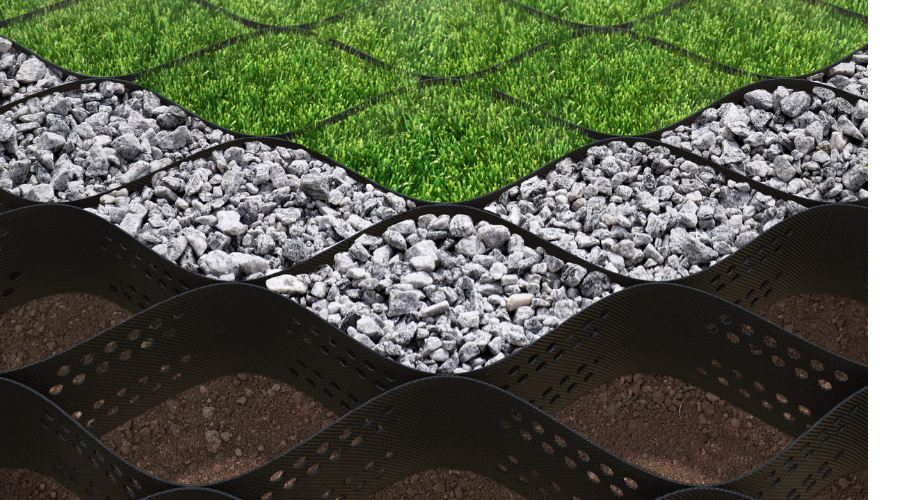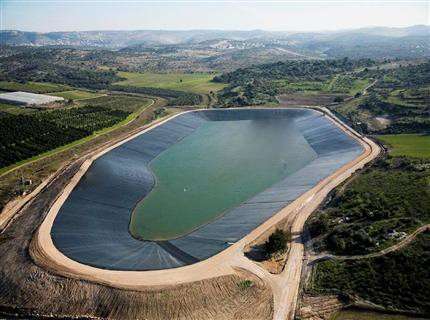
Blog

May 26,2023
How is a Geosynthetic grass grid used for storm water management and soil erosion control?
A geosynthetic grass grid is a type of reinforced grass system that combines synthetic grass with a plastic grid or mesh. The plastic grid provides stability and support for artificial grass by allowing water to drain.
Role Of Geosynthetic Grass Grid in Storm Management
A geosynthetic grass grid is recommended, especially for stormwater management; this grid helps slow down the flow of water and allows it to penetrate the ground, reducing the amount of overflow, which may result in soil erosion and flooding. This is especially important in areas prone to heavy rainfall or flooding. The grid also filters out pollutants and sediment from the water to improve the quality of the released water into streams and rivers.

Storm Water Management in Cities
A geosynthetic grass grid effectively manages stormwater overflow in urban areas where traditional green infrastructure solutions cannot be implemented. In densely populated cities, it is pretty challenging to find space for rain gardens, bioswales, or detention ponds; a geosynthetic grass grid can be installed, as an alternative, on top of surfaces such as rooftops, parking lots, and sidewalks to provide a porous surface just to allows water to infiltrate the ground.
Areas With Heavy Traffic
This grass grid provides an ideal solution to manage stormwater in areas where heavy traffic is expected, especially highways and bridges, by offering a durable and stable surface that endures heavy loads while allowing the water to absorb into the ground.
Ability To Blend in With Other Methods
A geosynthetic grass grid is being used with other geosynthetic materials, like high-quality drainage boards for stormwater management, along with different techniques, such as rain gardens, bioswales, and detention ponds. These techniques are also used to store water; when the grid slows down the flow of water and allows it to infiltrate the ground, it improves the overall effectiveness of stormwater management systems.
Role Of Geosynthetic Grass Grid in Soil Erosion
Geosynthetic grass grid is hailed for soil erosion control. The grid is made up of a plastic mesh filled with soil and seeded with grass. The mesh is laid on top of the ground, and the grass grows through the holes in the mesh. In the areas with steep slopes or which are prone to landslides, the grass and soil in the grid hold the ground in place and stabilize the soil by providing a physical barrier that makes the earth less likely to shift, thus preventing it from washing away during heavy rainfall or other harsh weather. The grid also enables the vegetation to grow, which can further help stabilize the soil and prevent erosion.
Other Techniques to Control Soil Erosion by Using Grass Grid
• To control soil erosion, reinforcement of the soil structure is another way to prevent soil erosion by using a geosynthetic grass grid. The plastic mesh of the grid provides structural support that helps to resist the forces of water and wind, which result in soil erosion. This reinforcement helps to keep the soil in place and prevents it from washing away.
• This grass grid is also used to repair areas already damaged by erosion. By installing this grid on top of the damaged soil, we can provide a stable surface for vegetation to grow and help to stabilize the soil. This is an effective erosion repair solution, as it is done quickly and at a lower cost than other methods.
Another advantage of a geosynthetic grass grid is that it is easy to install and maintain, which makes it a cost-effective solution for soil erosion control. Once installed, it requires very little maintenance, making it sustainable for controlling soil erosion problems.
How To Install Grass Grid for Soil Erosion Control and Storm Water Management
To install a geosynthetic grass grid to control soil erosion and manage stormwater, these simple and general steps are followed;
1. Prepare the site: Clear the area of any wreckage or existing vegetation. Mark the location to the desired shape and delineation.
2. Install a drainage layer: Install a layer of crushed stone or gravel to ease the drainage and prevent water from pooling on the surface.
3. Lay the geosynthetic grass grid: Unfold the grid and position it on the drainage layer. Ensure the grid is aligned correctly, and there must be no wrinkles or bubbles.
4. Secure the grid: Put the grid in place using stakes or pins. Ensure that the grid is stretched tight to prevent movement.
5. Install the grass: Spread a layer of earth over the grid and then sow grass seed or lay grass.
6. Maintain the area: We can maintain the geosynthetic grass grid by regularly mowing the grass and removing dirt.
These steps and materials may vary depending on the size and location of the area and the type of geosynthetic grass grid being used. Following professionals' or manufacturers' instructions and recommendations is always best.







